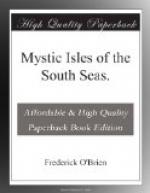They had no taro planted, though there was much about. Taro, the staple food of Hawaiians, either simply boiled or fermented as poi, was not a decided favorite in Tahiti. The natives thought it tasteless compared with the fei, so rich in color and flavor. The taro is a lily (Arum), and its great bulbs are the edible part, though the tops of small taro-plants are delicious, surpassing spinach, and we had them often on our table.
Our customary meals at eleven and at six were of raw oysters, shrimp, crabs, craw-fish, or lobsters; fish of many kinds, chicken, breadfruit, vi-apples stewed, bananas, oranges, feis, cocoanuts, and sucking pigs. The family ate sitting or squatting on the ground, but I had a table and silver, glass and linen. It is the way of the Tahitian. The big house, well furnished, was not inhabited by the chief’s family. It was their monument of success. They slept in one of several houses they had near by, and their elegant dishes were unused except for white guests.
On the beach at the river’s mouth the heron sat or stalked solemnly, and the tern flew about the reef. The white iitae lived about the cocoanut-trees.
From the broad veranda in front was a view of the sea, and all day and night the breakers beat upon the reef a mile away, now as soft as the summer wind in the lime-trees of Seville, and again loud as winter in the giant pine forests of Michigan. The fleecy surf gleamed and shimmered in the sun as it rolled over the coral dam, and when the sea was strong, there was another sound, the lapping of the waves on the sand a hundred yards from me. A little wharf had been built there by the Government, and a schooner arrived and departed every few days, with people and produce.
I ate alone mostly, at a table on the veranda in front of my chamber, waited on by Tatini, a very lovely and shy maiden of fourteen years. To her I talked Tahitian, as with all the family, in an effort to perfect myself in that tongue.
I was happy that I had pulled up anchor in Papeete, and as contrast is, after all, comparative, I felt like a New-Yorker who finds himself in Arcadia, though I had thought Papeete, on first sight, the garden of Allah. In Mataiea I realized the wonder of the Polynesian people, and found my months with the whites of the city a fit background for study of and ardent delight in the brown islanders I was to know so well.
Chapter XVII
My life in the house of Tetuanui—Whence came the Polynesians—A migration from Malaysia—Their legends of the past—Condition of Tahiti when the white came—The great navigator, Cook—Tetuanui tells of old Tahiti.




